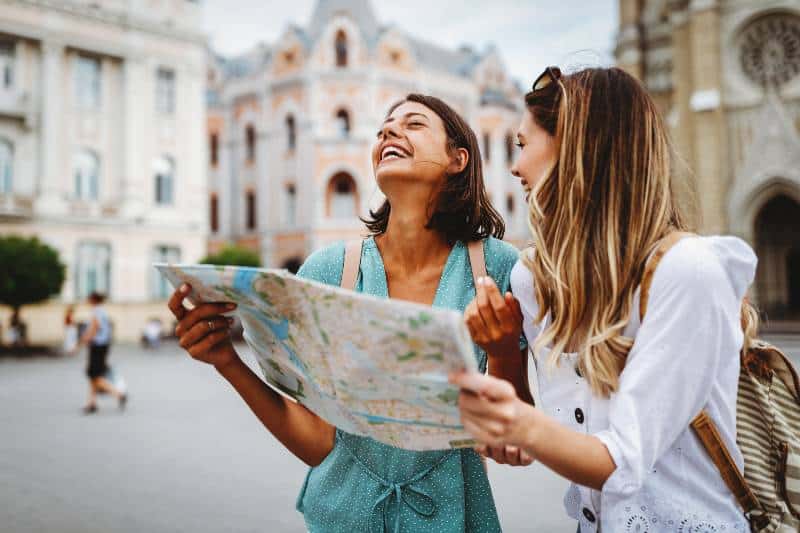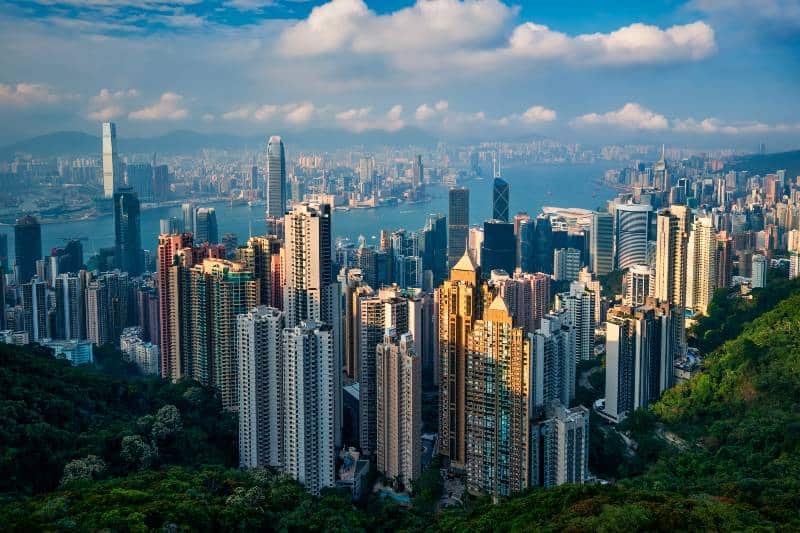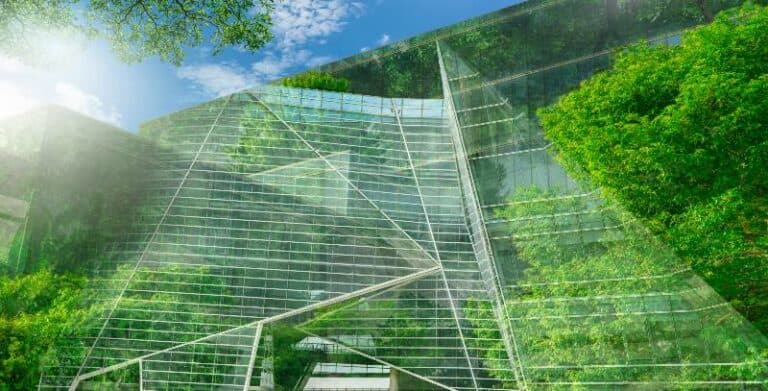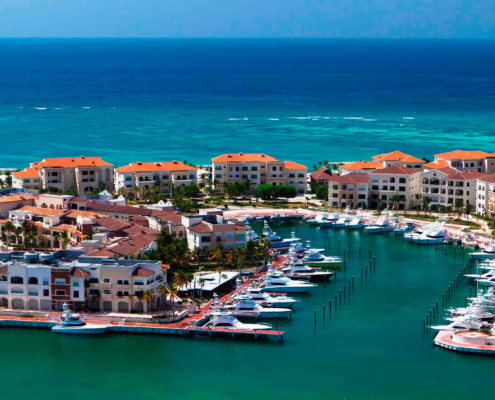

The Relationship Between Real Estate and Tourism
Here, we'll embark on a trip to unravel the symbiotic relationship between real estate and tourism!
Welcome, fellow explorers, to the intriguing intersection of two dynamic realms - real estate and tourism.
Picture this: the bustling cityscape dotted with architectural marvels, serene beachfront properties, and charming countryside retreats.
In this blog post, we embark on a journey to unravel the symbiotic relationship between real estate and tourism, where each element complements and shapes the other in a fascinating dance of supply and demand.
The Dance Begins: Tourism Boosts Real Estate

(Photo from CGTN)
In the grand ballroom of economic ecosystems, tourism takes the lead as a charming partner that ignites the spark in the real estate market. When tourists flock to a destination, they bring with them a surge in demand for accommodation, whether it's luxurious hotels, cozy bed and breakfasts, or trendy vacation rentals. This influx of visitors doesn't just fuel the hospitality industry but also sends ripples through the real estate market.
Consider the iconic cityscapes around the world. The allure of cultural landmarks, bustling streets, and vibrant nightlife draws tourists like moths to a flame. As a result, property values in these prime locations skyrocket, prompting real estate developers to seize the opportunity and build high-rise condominiums, boutique hotels, and chic apartments. The demand for real estate in tourist hotspots becomes a driving force for urban development, transforming skylines and neighborhoods into dynamic, sought-after hubs.
Moreover, the tourism effect is not confined to metropolitan areas. Charming coastal towns, picturesque countryside retreats, and historic villages find themselves in the spotlight as travelers seek unique and authentic experiences. This surge in demand for properties in these hidden gems revitalizes local real estate markets, breathing new life into forgotten corners of the world.
The Tango of Development and Infrastructure:
As the music of tourism plays on, real estate and infrastructure execute an intricate tango. The need to accommodate an increasing number of visitors propels destination cities and towns to invest in infrastructure development. Improved transportation, upgraded public spaces, and enhanced amenities become the jewels in the crown of tourist-centric locales.
Real estate developers, keenly aware of the rising demand for properties in these transformed areas, join the dance by investing in ambitious projects. Waterfront promenades, cultural districts, and state-of-the-art entertainment venues become the stage upon which the real estate market shines. It's a symbiotic relationship where the demand for tourism fuels development, and development, in turn, enhances the allure for both tourists and potential property buyers.
The AirBnB Waltz:

(Photo from Chegg)
In this modern age, the dance floor witnesses a unique partner - the sharing economy. Enter Airbnb, the disruptor that brought a fresh tempo to the real estate and tourism symphony. Homeowners and property investors suddenly had a platform to showcase their spaces to a global audience, offering tourists a more personal and authentic experience.
This game-changer not only expanded the options available to tourists but also sparked a revolution in the real estate market. Property owners found new avenues for income, whether it was renting out a spare room or transforming an entire property into a vacation rental. Cities witnessed a surge in short-term rental properties, challenging traditional notions of accommodation and pushing real estate markets to adapt to this evolving landscape.
The Challenge of Overtourism:
.png?width=700&height=420&name=ezgif.com-webp-to-png%20(10).png)
(Photo from The Guardian)
In any dance, missteps are inevitable. The real estate and tourism waltz is no exception, facing the challenge of overtourism. When the demand for a destination becomes overwhelming, it can lead to detrimental effects on both the environment and the local community.
Skyrocketing property prices, crowded streets, and overdeveloped landscapes are symptoms of overtourism, prompting destinations to reevaluate their steps. The delicate balance between catering to tourists and preserving the unique charm of a locale becomes a crucial consideration for both real estate developers and local authorities.
To conclude, as we bid adieu to the captivating dance floor of real estate and tourism, it's evident that this relationship is not a one-size-fits-all affair. Each destination has its own rhythm, influenced by factors such as culture, geography, and local policies. The symbiotic dance continues to evolve, shaping skylines, fostering economic growth, and creating unforgettable experiences for both tourists and locals alike.
So, whether you're a property enthusiast or an avid traveler, keep an eye on the ever-changing dynamics of the real estate and tourism tango. The next hotspot may be just a plane ride away, waiting to reveal its unique steps in this mesmerizing dance of development and discovery.
As always, thank you guys so much for taking the time to read this blog post - we here at Transactly are always grateful for the support! Stay tuned for more content coming every Monday, Wednesday, Friday, and Saturday.
We'd also like to list down the following sites that provided the inspiration for this blog post - go give them a read as well:
LinkedIn Pulse (1) - https://www.linkedin.com/pulse/how-real-estate-connected-tourism-what-its-importance-yasir-khan/
LinkedIn Pulse (2) - https://www.linkedin.com/pulse/real-estate-tourism-symbiotic-relationship-economic-roberts-castro/
Crown Asia: https://www.crownasia.com.ph/lifestyle-blog/how-does-tourism-affect-the-real-estate-market/
Similar posts
How real estate agents can build a professional network on linkedin.
Here, we'll explore how agents can use LinkedIn to forge valuable connections and strengthen their brand in the competitive world of real estate -...
Urban Metamorphosis: The Influence of Micro-Mobility Trends on Real Estate
In this blog, we'll explore the world of micro-mobility trends and examine its impact on real estate - read on to find out how!
The Hybrid Agent: Balancing Digital and Traditional Real Estate Practices
Here, we'll talk all about what it means to be a hybrid real estate agent - read on!
Get notified with new real estate posts.
Be the first to know about new real estate tech insights. Subscribe to stay up-to-date with Transactly.
The Impact of Tourism Boom on Commercial Real Estate Landscape

Commercial real estate is rising in popularity among investors, with tourism being an important factor to consider. Tourist spending has a direct impact on the value of investments and can provide unique opportunities for savvy investors who are looking to make a profit off their commercial properties. In this blog post, we’ll take a look at how tourism affects different types of commercial real estate investments, from hotels to restaurants and everything in between.
We’ll review key statistics related to tourist activity as it applies to business investment, discuss strategies for making returns on your property investments, and explore opportunities presented by both domestic and international tourism markets. Read on to learn more about the powerful influence of tourism when it comes to investing in commercial properties!
Several factors contribute to the success of a commercial real estate investment property, and one crucial aspect to consider is tourism. Tourism not only attracts more investors to a destination but also drives up property values, intensifies competition for prime real estate locations, and fosters further development. By taking tourism into account, investors can make informed decisions that maximize their potential for success in the tourism real estate market.
Key Takeaways
- Tourism and commercial real estate are deeply intertwined, with each influencing the other’s growth, challenges, and opportunities.
- While tourism can boost commercial property values and demand, over-reliance can lead to overdevelopment and strain on resources.
- In 2022, the U.S. saw significant growth in outbound tourism with a market value of $101.7 billion. The Travel & Tourism industry is projected to reach $190.4 billion in revenue by 2023. Additionally, inbound visitors spent $12.6 billion on travel and tourism-related activities in the U.S., a 105% increase compared to May 2021.

The Influence of Tourism on Commercial Real Estate: A Transformational Lens
Tourism significantly contributes to shaping the contours of commercial real estate. The evolution of this impact over time reveals intriguing insights into the symbiotic relationship between these two sectors. By delving into historical context and specific city examples, we can better understand this dynamic.
Historically Shaped By Tourism
The influence of tourism on commercial real estate has been a consistent theme throughout history. Tourism influx often boosts local economies, translating into growth in the commercial real estate market. As tourism-driven demand for services like accommodation, food and beverage, and retail increases, there’s a proportional rise in related commercial real estate’s value and development.
City Transformations by Tourism
Cities and regions the world over have experienced dramatic transformations, largely driven by thriving tourism industry. Take Barcelona, for instance. The Spanish city has seen a vibrant evolution in its commercial real estate since the 1992 Olympics – a colossal event which marked the city on the global tourism map.
It resulted in the significant development of hotels, restaurants, and retail spaces. Similarly, Dubai’s strategy of positioning itself as a global tourist destination has led to rapid tourism development and the meteoric rise of its commercial real estate sector.
The Tsai Research: Built Tourism Resources’ Influence
According to a research piece by Henry Tsai from The Hong Kong Polytechnic University, there is a notable correlation between tourism facilities and property value. Initial studies indicated a positive effect of natural resources on the value of nearby properties. Lately, scholars have expanded their focus on ‘built’ tourism resources, such as resorts and sports facilities.
Their influence on both housing prices and surrounding property value is increasingly acknowledged as these constructed attractions not only draw tourists but also promote the areas as desirable locations for commercial activities. The influx of tourism enhances demand for services and goods, which in turn stimulates the local commercial real estate market. Be the focus natural or built, the influence of tourism on commercial real estate remains compelling.
Property Types
Tourism bears a significant impact on diverse segments of commercial real estate, helping shape the demand and value of various property types. Here are some areas that most directly reap the benefits of the tourism sector’s dynamism:
Hotels and Resorts: Beneficiaries at the Forefront
When it comes to tourism development’s immediate effects, hotels and resorts usually lead the charts. These properties serve as the mainstay for tourists and handle the primary demand created by the influx of visitors. The growth of tourism directly correlates with the expansion and success of these hospitality establishments.
Retail Spaces: Meeting Tourist Shopping Desires
With tourism comes the inevitable surge in retail activity. From standalone shops to grand shopping malls and bustling local markets, retail spaces distinctly benefit from tourism. These establishments cater to tourists’ unique shopping needs, offering local crafts, brand-lined offerings or even mundane necessities. The growth of retail spaces is undeniably linked to the consumption habits of tourists.
Restaurants, Cafes, and Entertainment Venues
Food & beverage and entertainment locales substantially gain from a thriving tourism sector. Tourists exploring local cuisines and cultures inevitably frequent restaurants, cafes, and other entertainment venues. These popular hangouts become highlights of the travel experience, leading to their prosperity in regions with high tourist traffic.
Cultural Spaces: Showcasing Artistic and Historical Wealth
Cultural establishments such as museums, art galleries, and theaters also experience a positive ripple effect. Tourists are often drawn to these cultural hotspots to engage with local history, art, and culture, leading to boosted activity and revenue for such properties.
Mixed-Use Developments: A Composite of Needs
Mixed-use developments, which weave together residential, retail, and recreational spaces, also see an evolution propelled by tourism demand. These multifunctional properties cater to a variety of tourist needs, encapsulating accommodation, shopping, dining, and entertainment under one roof.
The demand and success of these developments often echo the ebb and flow of tourism trends. In 2022, the U.S. outbound tourism market was valued at US $101,697 million , while revenue in the Travel & Tourism market is projected to reach $190.40 billion in 2023. Moreover, inbound visitors spent $12.6 billion on travel to, and tourism-related activities in the U.S., up 105% compared to May 2021.
The impact of tourism extends its hands to various segments of commercial real estate. From hospitality-focused real estate like hotels and resorts to retail spaces and cultural establishments, they all tie their growth and success to the throbbing pulse of the tourism industry.
Investment Dynamics in Tourism-Driven Real Estate
The lure of tourism-centric properties transcends mere interest, creating a broader canvas filled with nuanced trends, key influencing factors, and potential risks and rewards. Through illustrative case studies, we can unearth successful narratives of tourism-driven real estate investments.
Investment Trends in Tourism-Driven Real Estate
The investment landscape of tourism-oriented real estate has witnessed noteworthy shifts and turns. Investment interest has been steering towards mixed-use developments in recent years, owing to the broad range of services they offer, making them highly attractive to tourists. Eco-tourism developments also have seen a surge in interest, aligning with the global rise in sustainable travel trends.
Furthermore, digitally-driven concepts such as home-sharing platforms have unveiled an alternate route for individual investors to tap into tourism’s profitable potential, with properties in prime tourist locations garnering substantial returns.
What Draws Investors to Tourism-Centric Properties
The chief allure for investors in tourism-centric properties lies in the potential for robust return on investment. Tourism hubs tend to sustain high occupancy rates year-round, translating into steady income streams. Furthermore, these locations often see appreciable property value growth, offering the prospect for capital gains in addition to rental income.
The vibrant and varied needs of tourists have given rise to innovative property types, offering investors plenty of options to match their specific risk profiles, investment goals, and interests.
Risks and Rewards of Investing in Tourist Areas
Investment in tourism-oriented real estate is associated with a unique risk-reward matrix. High footfall in tourist areas can yield lucrative rental returns and, over time, an increased valuation of the property. However, this also exposes investors to risks such as seasonal variations in footfall or unforeseen global events, like pandemics.
Property maintenance costs can be elevated due to high usage, and intensified regulations and licensing requirements associated with tourism also add to the complexity. However, these risks are often offset by the potential for consistently high demand, especially in well-known or burgeoning tourist destinations.
Illuminating Success Stories of Tourism-Driven Investments
Various successful cases in tourism-driven real estate investments worldwide underscore their potential. The consistent growth of mixed-use developments in Dubai, for instance, spotlights a winning formula. Combining luxury residential spaces with retail and leisure facilities, these properties are an irresistible draw for tourists, resulting in attractive and sustained returns for investors.
Another example is Orlando, Florida, renowned for its enchanting theme parks. The city’s high visitor influx has fueled massive success in the vacation home rental market, making real estate investment and tourism investment here a fruitful venture.
In sum, tourism-driven real estate investments offer rich prospects. By understanding the underlying trends, attractiveness, risk-reward trade-off, and drawing valuable insights from successful investments, investors can be well-positioned to capitalize on the growth of tourism’s love affair with real estate.
Seasonality of Tourism
The ebb and flow of tourist arrivals, occasioned by the cyclical nature of tourism, wield substantial influence on property prices and demand, challenging the commercial real estate sector to adapt and devise ingenious strategies for seasonality.
Cyclical Tourism and Its Impact on Property Demand
Tourism, by nature, experiences peaks and valleys, often driven by seasons, and sometimes, by factors like events and school holidays. These oscillations have significant implications for the real estate industry. Peak seasons typically bring about high demand, potentially pushing property values up and boosting the overall business environment. However, during lulls, reduced visitor numbers may lead to lower property demand, potentially affecting profitability and occupancy rates.
Weathering the Off-Peak Seasons: Strategic Approaches
Managing off-peak seasons effectively is crucial to maintaining profitability in the commercial real estate sector. An emerging strategy is to offer discounted rates during low seasons to attract tourists looking for less crowded, cost-effective travel experiences. Likewise, property owners often schedule routine maintenance and renovation during these periods to ensure optimal service during high seasons.
Furthermore, targeting different tourist types can also help. For instance, marketing luxurious, serene retreats to older tourists or digital nomads during off-peak months might counterbalance the reduced influx of holiday tourists.
Leveraging Events, Festivals, and Attractions
Special events, festivals, and local attractions play a vital role in driving year-round tourism. Cities that host significant events, such as music festivals, sports tournaments, or international conferences, often witness consistent visitor numbers irrespective of the season.
Likewise, regions with unique attractions such as vineyards, historical sites, or theme parks also typically enjoy sustained footfall. Leveraging these attributes to diversify and stretch the tourist season is an effective way to combat the cyclical downturns in tourism.
In summary, the undulations of tourism seasons present both challenges and opportunities to the commercial real estate sector. A shrewd understanding of these cycles, effective off-peak as well as boom property management strategies, and capitalizing on local attractions and events can instill resilience in property demand, ensuring healthy returns throughout the year.
Positive Outcomes of Tourism on Commercial Real Estate
Tourism, with its power to invigorate economies, brings about an array of beneficial impacts on commercial real estate. An appreciation of property values, sustained demand for specific property types, and the birth of new business possibilities are among the many positive outcomes.
Appreciation of Property Values
An influx of tourists often translates into a thriving local economy. This heightened economic activity can lead to an increase in the value of commercial real estate. Prime locations and well-maintained properties, especially those that cater directly to tourists such as hotels, restaurants, and retail spaces, are likely to see the most significant appreciation in values. This appreciation benefits property owners and investors, contributing to rental prices and higher returns.
Sustained Demand for Certain Property Types
Tourism can boost demand for specific types of commercial real estate. Properties like hotels and other lodging establishments see increased, sustained usage due to tourists. Retail spaces and food & beverage establishments also experience a surge in demand as tourists shop for souvenirs, dine out, and explore the local culture. This demand often remains resilient, even during economic and housing price fluctuations, given the standing allure of travel for many.
Creation of New Business Opportunities
Tourism often leads to the creation of new business opportunities, contributing to the dynamism of the commercial real estate sector. For instance, growth in tourism can incentivize the development of unique property types, such as glamping sites, boutique hotels, or experiential retail stores.
Similarly, it has the potential to transform real estate usage – an old factory might be repurposed into a thriving cultural market or a series of abandoned buildings turned into unique vacation rentals. These new uses energize the property market, attracting innovative investors and fostering a continuously adaptable real estate landscape.
The influence of tourism on commercial real estate is profound and positively transformative. Through the appreciation of residential property values itself, the enhanced and sustained demand for certain property types, and the birth of new business opportunities, tourism emerges as a pivotal pillar in the prosperity of the commercial real estate sector.
Challenges and Negative Impacts of Tourism on Commercial Real Estate
While tourism undeniably shoulders the prosperity of the commercial real estate sector, it can also foster unique challenges and negative impacts. Seasonality, the potential for overdevelopment, and the strain on local resources and infrastructure encapsulate some of the pressing concerns.
Seasonality and Dependence on Tourism
The cyclical nature of tourism causes fluctuations in demand for commercial properties. Peak seasons bring inundating tourism activity, while off-peak times often see low property usage and income. This seasonality could lead to financial instability for businesses unable to effectively manage these cycles.
Furthermore, over-reliance on tourism creates vulnerability. Sudden global events, economic downturns, or shifts in travel behavior can lead to notable declines in visitor numbers, impacting property demand and occupancy rates.
The Risk of Overdevelopment
Driven by the prospect for robust returns, real estate developers and investors might overextend, leading to an oversupply of tourism-oriented properties. Overdevelopment could result in excessive competition, diminishing profits, and wasted resources. Moreover, abandoned constructions or underutilized properties impact the aesthetic appeal and overall environment of a region.
Strain on Local Resources and Infrastructure
A tourism boom often demands more power, water, waste disposal, and transportation services, placing a strain on local resources and infrastructure. Not only does this raise concerns about sustainability, but it can also lead to deterioration in the quality of life for local residents.
Commercial properties might also face increased costs for utilities and services during high-load periods. Moreover, enhancing infrastructure to meet tourist demands can raise property and construction costs, potentially less housing affordability and inflating market prices.
In conclusion, while tourism is largely beneficial for commercial real estate, it does come with its set of challenges. Understanding and addressing these issues—seasonality, overdevelopment, and the strain on the local community, infrastructure and resources—is crucial to sustainably harness tourism’s potential for commercial real estate success.
Case Studies: Tourism and Commercial Real Estate
Tourism’s impact on commercial real estate is conspicuous in various cities and regions worldwide. Let’s delve into a few examples, outlining their experiences and lessons learned.
Case Study 1: Dubai, UAE
Dubai, a global tourism hub, has commercial real estate significantly impelled by tourism. The city’s transition from an oil-based economy to one focused on tourism and real estate showcases how embracing tourism can revitalize an entire region.
Lesson Learned: Dubai demonstrates the value of diversification in property types — luxury hotels, mega malls, unique attractions like the Burj Khalifa, man-made islands, and the development of trade and exhibition centers. This diversity attracts a diverse range of tourists and secures different income streams, mitigating risks associated with over-reliance on a single property type or tourist demographic.
Case Study 2: Barcelona, Spain
The Catalan city is renowned for its lucrative tourism industry. However, the boom in tourism led to an oversupply of short-term holiday lets, negatively impacting the local housing market and community.
Lesson Learned: Barcelona’s experience underscores the importance of regulatory measures in maintaining balance in commercial real estate. The city has imposed restrictions on short-term lets and is implementing strategies to control tourism, reflecting the need for careful management and regulation in cities profoundly impacted by tourism.
Case Study 3: Orlando, Florida, USA
Orlando, with its vast array of amusement parks, consistently attracts substantial tourists, causing boom properties in tourism related income for commercial real estate – hotels, vacation rentals, retail, and food & beverage establishments.
Lesson Learned: Orlando’s experience underlines the importance of having major, year-round attractions to maintain consistent tourist influx, mitigating the impact of seasonality. The city also exemplifies how well-managed tourism growth can sustain a vibrant real estate market.
These case studies from Dubai, Barcelona, and Orlando illustrate various facets of tourism’s impact on commercial real estate. They emphasize the benefits of diversified offerings, the need for controlled growth, and potential strategies for seasonality management. By absorbing these lessons, stakeholders can formulate policies and strategies that embrace the benefits of tourism while mitigating its challenges.
Future Trends in Tourism and Commercial Real Estate
Several evolving trends give a glimpse into the future of tourism and its impact on commercial real estate. Sustainable tourism, the rise of virtual tourism and remote work, and shifts expected in the post-pandemic world emerge as significant themes.
The Challenge of Sustainable Tourism
Attuned to growing global environmental concerns, sustainable tourism is set to play a vital role in shaping the commercial real estate market. This concept builds upon the idea of developing and managing tourist spaces in a manner that respects local cultures, preserves the environment, and promotes socio-economic benefits for host communities.
Investors and developers will need to adopt eco-friendly design elements and operational practices, such as energy-efficient buildings, reduced water usage, and waste management systems. Green certifications may also become important selling points, adding value to properties.
The Emergence of Virtual Tourism and Remote Work
Virtual tourism, propelled by advances in technology like VR and AR, is promising an alternative travel experience. While it’s unlikely to replace traditional tourism, it may impact the demand for tourist-specific commercial real estate, especially tailored towards experiential tourism.
The rise of remote work culture has instigated a new trend of prolonged stays. Commercial properties, particularly serviced apartments and co-working spaces, would need to accommodate this new demographic, offering long-term stays with work-friendly environments.
Predictions for the Post-Pandemic World
The global pandemic has accelerated various trends and has prompted a reassessment of tourism’s role. As international travel normalizes, a rebound in tourism and subsequently, commercial real estate, is widely expected.
The emphasis, however, may shift towards localized, less crowded experiences, boosting rural and suburban real estate markets. Health and safety considerations will be paramount — properties offering contactless services, rigorous cleanliness protocols, and flexible booking policies would likely gain preference.
In conclusion, sustainable practices, the advent of virtual tourism and remote work, and adjustments ushered in by the pandemic are set to reshape the tourism-commercial real estate landscape. By staying abreast of these trends and adapting to them, the commercial real estate sector can continue to reap the benefits of a dynamic tourism industry.

The Impact of Tourism on Commercial Real Estate FAQs
How is real estate related to tourism.
Commercial real estate and tourism have a symbiotic relationship. As tourism drives demand for accommodations, attractions, shopping, and dining, it also impacts the development of commercial properties in these areas. In turn, well-managed commercial real estate helps attract and enhance the overall tourism experience, creating a cycle of mutual benefit.

Why does the Philippines need to develop tourism focused real estate?
The Philippines relies heavily on tourism as a significant contributor to its economy. Developing tourism-focused real estate can not only enhance the overall tourist experience but also provide additional revenue streams for the country. It can also create job opportunities and stimulate economic growth in areas that may not have been traditionally popular among tourists.
How does tourism affect the housing market?
The impact of tourism on the housing market can vary depending on the specific location and type of tourism. In some cases, an increase in tourism can lead to higher demand for short-term rentals, driving up housing prices, and reducing available long-term housing options. This can negatively affect local residents, making it more difficult to find affordable homes.
What are the impacts of the tourism industry?
The tourism industry can have both positive and negative impacts on the areas it affects. On one hand, it can bring in significant revenue, create job opportunities, and contribute to economic growth. On the other hand, it can also put pressure on local resources and infrastructure, cause overcrowding and strain relationships with local communities.
What is the biggest impact of tourism on the economy?
Tourism offers a significant advantage: the ability to generate revenue through foreign exchange earnings. When tourists spend money, it contributes to the income of the host economy. These funds can then be reinvested into the country’s economy, fostering further growth and development.
From the rise of virtual experiences to sustainable real estate tourism, the link between commercial real estate and tourism will be continuously evolving. Although there are numerous ways that tourism can impact real estate landscape and markets, all in all, it is clear that travel and commerce are distinctly interdependent. Significantly, this creates a unique set of challenges and opportunities for companies in both industries.
So if you’re interested in finding out more regionally-specific information, or wish to discuss strategies regarding how to best leverage this relationship for future success, make sure to call or schedule a free consultation with me at Tolj Commercial real estate. As an experienced real estate professional, I’m here to answer your questions and help you get the most out of your investment ideas.
Blog Articles Disclaimer
The information presented in articles on our website or affiliated platforms is exclusively intended for informational purposes. It’s crucial to grasp that this content does not constitute professional advice or services. We strongly recommend our readers to seek guidance from appropriately qualified experts, including, but not limited to, real estate and other attorneys, accountants, financial planners, bankers, mortgage professionals, architects, government officials, engineers, and related professionals. These experts can offer personalized counsel tailored to the specific nuances of your individual circumstances. Relying on the content without consulting the relevant experts may hinder informed decision-making. Consequently, neither Tolj Commercial Real Estate nor its agents assume any responsibility for potential consequences that may arise from such action.
Mike Tolj specializes in representing business owners and landlords in the leasing and sale of commercial properties. He has over 18 years of experience in the industry and knows how to get deals done quickly and efficiently. Mike is passionate about helping business owners and landlords alike achieve their real estate goals. He has a track record of achievement, having completed numerous transactions for his clients.
Similar Posts

Sustainable Property Management: A Guide
Win-Win Deals: Expert Strategies for Negotiating Commercial Leases

Effective Tenant Vetting: Tenant Screening for Landlords

My Top Tips For Finding An E-commerce Warehouse

Rent Control in Los Angeles: A Comprehensive Look

Reshoring Manufacturing: What Is It, Why Do Companies Do It?

Rockland County Business Journal
Covering Rockland Business 24/7

The Impact of Tourism on Local Real Estate Markets
T ourism is more than just an opportunity for travelers to explore new destinations; it's a powerful economic force that significantly influences local real estate markets. As tourists arrive in new areas, their presence can catalyze changes in both residential and commercial property sectors. This influence creates a ripple effect that can alter the economic landscape of the entire community.
Rising Property Values
The immediate effect of increased tourism is often seen in property values. Mike Kotler, Founder of Move Ahead Homes and an active realtor, observes, "Tourism directly boosts demand for local real estate as visitors often seek second homes or investment properties in popular tourist destinations. This increased demand drives up property values, providing substantial benefits to local homeowners." The development associated with tourism, such as enhanced infrastructure and improved amenities, further increases property attractiveness and value.
Property developers are quick to capitalize on this trend, often accelerating their projects to match the growing demand. This development can lead to a robust construction industry, further stimulating the local economy through job creation and increased spending.
Impact on Rental Markets
The influx of tourists also transforms rental markets. Noah Guthart, Founder and COO of Panacrypto , points out, "Areas with high tourist attractions experience a surge in demand for short-term rentals. While this is lucrative for property investors, it also poses challenges for locals seeking long-term housing solutions." He explains that as more residential units are converted into vacation rentals, the availability of affordable long-term rentals diminishes, sometimes straining local housing markets.
This shift not only affects availability but can also alter the community dynamic, as transient populations replace longer-term residents. Local governments are often prompted to intervene, creating policies to balance the needs of tourists and residents to maintain community stability and quality of life.
Economic Impact Beyond Real Estate
The influence of tourism extends far beyond real estate. Pradeep Guragain from Magical Nepal highlights the broader economic impact: "Tourism elevates the demand for real estate and simultaneously boosts spending in retail, dining, and services. This comprehensive economic enhancement encourages further investments in local properties." As tourism flourishes, so does the local economy, with improved job opportunities and enhanced public services.
Tourists bring diverse cultural influences and new consumer preferences, which can lead to the emergence of new businesses catering to these tastes. From boutique hotels and specialty restaurants to unique local experiences, the business landscape evolves to meet the changing demands of visitors.
Challenges and Sustainable Development
Despite the apparent benefits, the impact of tourism on real estate markets is not without its challenges. Mike Kotler warns of potential pitfalls: "While the initial economic boost is beneficial, it's crucial for development to be managed sustainably. Rapid growth can lead to overdevelopment, which might spoil the natural charm and appeal of the area that attracts tourists initially."
Sustainable development is key to ensuring that tourism growth does not detrimentally impact the environment or the social fabric of the destination. Effective zoning laws, environmental regulations, and community engagement are essential in crafting a balanced approach that supports both economic growth and conservation efforts.
Infrastructure and Local Community
The infrastructure must keep pace with growth. From roads and transportation to utilities and public services, ensuring that the infrastructure can support both tourists and residents is vital for sustainable development. Overlooking this aspect can lead to significant problems, such as traffic congestion, water shortages, and inadequate waste management, which can degrade the quality of life for residents and diminish the area's attractiveness to tourists.
Furthermore, the impact on the local community must be considered. The influx of tourists can lead to a cultural shift, which might affect the local traditions and lifestyle. Communities need to find ways to embrace tourism without losing their identity, which requires careful planning and community involvement.
Enhanced Urban Development and Revitalization
On the positive side, tourism can lead to enhanced urban development and revitalization of neglected districts. Pradeep Guragain highlights the potential benefits, "Areas that were previously overlooked often receive significant attention once they become tourist destinations. This can lead to urban renewal projects that enhance these areas, making them more livable and attractive, not just to tourists but to local residents as well." Guragain notes that such developments can help preserve historic buildings and improve public spaces, contributing to a city's overall aesthetic and functional appeal.
Looking Ahead
As the global travel industry continues to expand, the interaction between tourism and real estate will become increasingly significant. For communities, this means navigating the challenges of integrating new developments with the needs of existing residents. For investors and policymakers, it presents an opportunity to shape the future of local economies through strategic planning and thoughtful management.
In conclusion, while tourism can indeed be a boon for local real estate markets, it must be handled with care and foresight. With proper planning and regulation, communities can harness the economic benefits of tourism while preserving their cultural heritage and natural landscapes for future generations.

- [email protected]
- +1 909 414 1393
- Report Details
- Table Of Content
- Request Free Sample

Global Tourism Real Estate Market by Type (Tourism Landscape Real Estate, Tourism Commercial Real Estate, Tourist Holiday Real Estate, Tourism Residential Real Estate), By Application (Rental, Sales) and Region (North America, Latin America, Europe, Asia Pacific and Middle East & Africa), Forecast From 2022 To 2030
- Table of Content
- Free Sample
Market Overview:
The global tourism real estate market is expected to grow at a CAGR of 6.5% during the forecast period from 2018 to 2030. The market growth can be attributed to the increasing demand for tourist holiday real estate, rising disposable income of consumers, and growing number of tourists across the globe. The tourism landscape real estate segment is expected to hold the largest share in the global tourism real estate market by type during the forecast period from 2018 to 2030. This can be attributed to increased investment in infrastructure development by governments across different countries and rising demand for luxury properties among consumers. The rental segment is expected to hold a larger share in terms of application during the forecast period from 2018-2030 owing to increase in number of short-term rentals.
Product Definition:
Tourism real estate is a type of real estate that caters to tourists. This can include hotels, resorts, and other types of accommodation. Tourism real estate is important because it helps to support the tourism industry, which is a key part of many economies.
Tourism Landscape Real Estate:
The tourism landscape real estate is the portion of land that is used for the purpose of accommodation and hospitality during tourism. It includes areas such as hotels, restaurants, camping sites, chalets and holiday homes. The growth factor in this market has led to an increase in demand for high quality holiday homes which are unique and different from any other home available in the market. This uniqueness attracts customers towards purchasing these properties even during their visits alone or with their families at a later stage.
Tourism Commercial Real Estate:
Tourism Commercial Real Estate (TCRE) is the part of hospitality industry which includes hotels, resorts, restaurants and pubs. TCRE also includes retail space in tourist areas as well as conference rooms and meeting rooms used by tour operators for their business purpose. The major factor driving the growth of tourism commercial real estate market is increasing number of international tourists across the globe.
Application Insights:
The rental application segment accounted for the largest revenue share of over 70.0% in 2017 and is expected to continue its dominance over the forecast period. This is attributed to a growing number of tourism projects across various countries in Asia Pacific, Africa, North America and Europe that are offering rentals as an alternative investment opportunity. For instance, Hyatt Hotels Corporation has launched a new line of luxury apartments named as ¢â‚¬ËœHyatt Regency¢â‚¬â„¢s Residences¢â‚¬ at various locations including Dubai, Paris, New York City and Los Angeles. The company also aims to expand this brand globally by 2030 which will provide more than 5500 rooms under different categories such as lifestyle hotels & resorts; full service hotels; romantic hotel; family friendly hotel etc., thus driving the demand for tourism real estate investments across the world.
Regional Analysis:
Asia Pacific dominated the global market in 2017 and is expected to continue its dominance over the forecast period. This growth can be attributed to increasing investments by international players, availability of cheaper labor, infrastructure facilities as well as high domestic demand for real estate projects. In addition, growing trend of travel and tourism has led to increased demand for accommodation which will further drive regional market growth.
The Asia Pacific region is home to some of the most popular tourist destinations across the globe such as Thailand, Singapore, Hong Kong Disneyland Resort & Universal Studios Singapore among many others. These properties are being purchased primarily by foreign investors looking for investment opportunities in this industry with an aim toward rental income generation or capital gain through sale option over a period of time - either short term (less than 1 year) or medium term (1-3 years).
Growth Factors:
- Increasing international tourist arrivals: The number of international tourist arrivals has been increasing consistently over the years. This is due to various factors such as increase in disposable income, growth in airline industry, etc. This provides a huge potential for the growth of tourism real estate market.
- Growth in MICE (Meetings, Incentives, Conferences and Exhibitions) travel: The global MICE travel industry is expected to grow at a CAGR of 6% from 2016 to 2020. This provides a huge opportunity for the growth of tourism real estate market as this segment generally requires large-scale infrastructure and facilities such as convention centers, hotels, etc.
- Proliferation of online booking platforms: With the proliferation of online booking platforms such as Airbnb and Booking Holdings Inc., tourists are now increasingly preferring to book their accommodation and other services online rather than through traditional channels such as travel agents or hotel chains. This presents a big opportunity for players in the tourism real estate market who can provide innovative solutions that cater to this trend.
Scope Of The Report
Global tourism real estate market report segments:.
The global Tourism Real Estate market is segmented on the basis of:
Tourism Landscape Real Estate, Tourism Commercial Real Estate, Tourist Holiday Real Estate, Tourism Residential Real Estate
The product segment provides information about the market share of each product and the respective CAGR during the forecast period. It lays out information about the product pricing parameters, trends, and profits that provides in-depth insights of the market. Furthermore, it discusses latest product developments & innovation in the market.
Applications
Rental, Sales
The application segment fragments various applications of the product and provides information on the market share and growth rate of each application segment. It discusses the potential future applications of the products and driving and restraining factors of each application segment.
Some of the companies that are profiled in this report are:
- Country Garden
Highlights of The Tourism Real Estate Market Report:
- The market structure and projections for the coming years.
- Drivers, restraints, opportunities, and current trends of market.
- Historical data and forecast.
- Estimations for the forecast period 2030.
- Developments and trends in the market.
Tourism Landscape Real Estate
Tourism commercial real estate, tourist holiday real estate, tourism residential real estate.
- By Application:
- Market scenario by region, sub-region, and country.
- Market share of the market players, company profiles, product specifications, SWOT analysis, and competitive landscape.
- Analysis regarding upstream raw materials, downstream demand, and current market dynamics.
- Government Policies, Macro & Micro economic factors are also included in the report.
We have studied the Tourism Real Estate Market in 360 degrees via. both primary & secondary research methodologies. This helped us in building an understanding of the current market dynamics, supply-demand gap, pricing trends, product preferences, consumer patterns & so on. The findings were further validated through primary research with industry experts & opinion leaders across countries. The data is further compiled & validated through various market estimation & data validation methodologies. Further, we also have our in-house data forecasting model to predict market growth up to 2030.
Regional Analysis
- North America
- Asia Pacific
- Middle East & Africa
- Latin America
Note: A country of choice can be added in the report at no extra cost. If more than one country needs to be added, the research quote will vary accordingly.
The geographical analysis part of the report provides information about the product sales in terms of volume and revenue in regions. It lays out potential opportunities for the new entrants, emerging players, and major players in the region. The regional analysis is done after considering the socio-economic factors and government regulations of the countries in the regions.
How you may use our products:
- Correctly Positioning New Products
- Market Entry Strategies
- Business Expansion Strategies
- Consumer Insights
- Understanding Competition Scenario
- Product & Brand Management
- Channel & Customer Management
- Identifying Appropriate Advertising Appeals
8 Reasons to Buy This Report
- Includes a Chapter on the Impact of COVID-19 Pandemic On the Market
- Report Prepared After Conducting Interviews with Industry Experts & Top Designates of the Companies in the Market
- Implemented Robust Methodology to Prepare the Report
- Includes Graphs, Statistics, Flowcharts, and Infographics to Save Time
- Industry Growth Insights Provides 24/5 Assistance Regarding the Doubts in the Report
- Provides Information About the Top-winning Strategies Implemented by Industry Players.
- In-depth Insights On the Market Drivers, Restraints, Opportunities, and Threats
- Customization of the Report Available
Frequently Asked Questions?
Tourism real estate is the sale of land, buildings and other properties that are used for tourism purposes.
Some of the key players operating in the tourism real estate market are Evergrande, Vanke, Country Garden, Poly, SUNAC, Greenland, R&F, CFLD, CR Land, Green Town, Evergrande, Wanda.
The tourism real estate market is expected to register a CAGR of 6.5%.
Report Payment
Request for sample, ask for discount, enquiry before buying, related reports.

Global Motor Trade Road Risk Insurance Market by Type (Third Party, Third party Fire and ...

Global Intelligent Apps Market by Type (Apple App Store, Google Play, Others), By Applica...

Global Automated API Testing Tool Market by Type (On-Premise, Cloud Based), By Applicatio...

Global Cryonics Technology Market by Type (Slow freezing, Vitrification, Ultra-rapid), By...

Global Multiexperience Development Platforms Market by Type (Cloud-Based, On-Premises), B...

Global Industrial Model Design and Fabrication Market by Type (High-end, Middle-end, Low-...
Our trusted clients.

Industry Growth Insights is Product of YOAAP Media Services LLP. | COPYRIGHT © 2024 IGI | All Rights Reserved.
Get call back from us

Thank you for subscribing to our newsletter. You Should receive a confirmation email soon.

Real Estate Tourism: The next step in the country’s tourism evolution
Source: El Nuevo Diario by Juan Feliz
Over the years, the Dominican Republic has established itself as a solid and dominant tourist destination in the entire region. It is no coincidence that in recent years it has become common to see world-renowned figures choose our land as the venue for their vacations. In short, our tourist boom is not by chance; rather it is due to the innumerable amount of natural settings of extraordinary beauty in the country, such as beaches, rivers, mountains, valleys, and sometimes even deserts. It could be said without fear of misunderstanding that the slogan “The Dominican Republic has it all” fits like a glove.

It is an unquestionable truth that real estate tourism is the perfect complement to hotel tourism in most countries. This wealth-forging entity generates thousands of indirect jobs and also allows the foreign investor not only to invest in our country but also to be a regular visitor to our nation. From then on, this real estate tourism investor becomes a perennial activator of the economy.
The truth is that the Dominican Republic has a large number of tourist destinations that have more than enough conditions to compete in the real estate tourism sector at an international level; There are clear examples of this, such as the Cap Cana destination city project, which coincidentally celebrates its 20th anniversary this year.
Cap Cana ho is establishing itself as one of the most reliable destinations and perhaps the main standard-bearer in the region of investment in real estate tourism, with a range of offers, ranging from sumptuous villas to luxury apartments, for which An investment of more than 3,000 million dollars was made to date.
You might also like

Let’s Connect

To read this content please select one of the options below:
Please note you do not have access to teaching notes, real estate and the development of tourism: conclusions of the 45th aiest congress.
The Tourist Review
ISSN : 0251-3102
Article publication date: 1 April 1995
Tourism accommodation is an affair for the real estate business. As a concept, tourism accommodation can only be defined and understood in terms of demand. When a tourist requires overnight accommodation, this product constitutes tourism accommodation. Looked at in this way a home for the aged, even when located in a tourism region, does not constitute tourism real estate. The World Trade Organisation (WTO) has classified different types of accommodation. This classification shows clearly what a great variety there is in types of tourism accommodation. The WTO list makes a particular distinction between collective types of accommodation and private accommodation. In the first category we find commercially operated hotels and para‐hotels. The second category concerns second homes which are either exclusively used by the owners or are at times made available to family and friends, at no charge.
Keller, P. (1995), "Real estate and the development of tourism: Conclusions of the 45th AIEST congress", The Tourist Review , Vol. 50 No. 4, pp. 3-5. https://doi.org/10.1108/eb058199
Copyright © 1995, MCB UP Limited
Related articles
We’re listening — tell us what you think, something didn’t work….
Report bugs here
All feedback is valuable
Please share your general feedback
Join us on our journey
Platform update page.
Visit emeraldpublishing.com/platformupdate to discover the latest news and updates
Questions & More Information
Answers to the most commonly asked questions here

Tourism is back and already in these early months of 2023 there is a real boom in arrivals, presences and overnight stays . All industry surveys are in agreement, already talking about a record 2023.
According to the Demoskopika institute, presences in Italy in 2023 will be over 442 million (+ 12.2% over 2022) with 127 million arrivals (+ 11.2% over 2022, close to 128 in 2018 and the record 131 in 2019), of which 61 million foreigners for 215 million overnight stays.
Similar data are those found by AllTours and Making Science about bookings and requests for quotations, which grew by +43% compared to the same period in 2022 and with an average expenditure expected to rise by 14% to almost 2000 euros.
Tourism expenditure and profitability of facilities in Italy
Tourism expenditure in Italy in 2023 is therefore expected to touch the EUR 89 billion mark , with an estimated growth of 22.8% compared to 2022 but above all a profitability that has surpassed pre-pandemic levels with a double-digit increase in ADR (the average daily rate per room).
A trend that has already been confirmed in the first months of 2023 with the improved performance of both occupancy rates and average rates, as emerged during the ‘ Tourism to come: a reading through hospitality in Italy ‘ conference held on 22 March at Milan’s Bocconi University and promoted by Confidustria Alberghi, Assolombarda and the university’s Master in Tourism Economics.
The choices of foreign tourists
Among foreign tourists , at least 20% of those who have been to Italy in the last five years claim to have been there at least three times, a ‘hard core’ attracted by Italian style (43.4% of cases), natural beauty (38.9%), cultural heritage (32.8%) and luxury. And precisely that of the high-end, according to data from an ENIT survey, is a fast-growing niche that does not suffer the repercussions generated by geopolitical tensions, health emergencies or economic crises.
What tourists are looking for when they choose Italy
Traditionally, the most popular destinations are by far the seaside resorts (36.8%) and cities of art (31.7%), for both Italians and foreign travellers, but according to the ENIT survey there is a growing interest in natural heritage (the first holiday motivation for 18.1% of Italians and 22.4% of foreigners) and in the small excellences of the territory, discovering villages and inland areas of the country. This is an important trend towards the goal of extending the tourist season and the deseasonalisation and decongestion of flows.
However, there is no shortage of criticalities in the Italian tourism system , as was also highlighted during the conference at Milan’s Bocconi University. In particular, despite the presence of chains, which account for 5.6% in Italy and are on the rise in the luxury segment, it is the quality of the facilities that leaves something to be desired, as they do not always meet customers’ expectations in terms of maintenance, service and connectivity.
A reputation warning not to be underestimated if tourism operators are to be guided towards investments that meet the needs of an increasingly demanding clientele.
In this regard, 700 million euro from Cassa Depositi e Prestiti (CDP) is already available to support the renovation of hotels, with the prospect of up to 1.1 billion euro to support national operators in the development and consolidation of their business.
This is a historic opportunity particularly in those regions whose percentage change in overnight stays is below or close to the Italian average, such as Campania (+12.3% in overnight stays for 20.8 million and +13.1% arrivals with 5.7 million) or Umbria (+10.0% in overnight stays for 6.4 million and +13.5% in arrivals with 2.6 million).
Because if 50 per cent of tourists return to their holiday destination and 1 in 10 do so to stay in the structure they trust ( Isnart data), it means that it is the companies that focus on quality services, innovation and environmental sustainability that are most rewarded by customers’ market choices.
Real estate investments in the hospitality segment
Thanks to the gradual recovery of hotel performance compared to pre-pandemic results, the interest of real estate investors in the hotel segment is growing in Italy.
In the area of value-add transactions, investors are showing particular interest in the capital, aiming at the repositioning of existing structures and the conversion of office buildings in the city’s historic centre, especially in the luxury and extra-luxury segment. Examples of this are the recent openings in Rome of Six Senses and the forthcoming openings of Bulgari and Four Seasons.
In Milan, on the other hand, flows were directed towards the upper-upscale segment with rebranding operations of existing hotels or the purchase of income hotels by core investors.
Thanks to the NRP funds, there is also growing interest in secondary Italian cities and southern regions, with Puglia, Sicily and Campania leading the way.
Privacy Overview

IMAGES
VIDEO
COMMENTS
The real estate and tourism waltz is no exception, facing the challenge of overtourism. When the demand for a destination becomes overwhelming, it can lead to detrimental effects on both the environment and the local community. Skyrocketing property prices, crowded streets, and overdeveloped landscapes are symptoms of overtourism, prompting ...
The real estate sector is one of the most lucrative sectors in the global economy, and it is one of the metrics for measuring the economic growth of any nation [1,2].The real estate sector affects, and is affected by, other economic sectors, including tourism.
While tourism can boost commercial property values and demand, over-reliance can lead to overdevelopment and strain on resources. In 2022, the U.S. saw significant growth in outbound tourism with a market value of $101.7 billion. The Travel & Tourism industry is projected to reach $190.4 billion in revenue by 2023.
Real estate development provides the necessary infrastructure, accommodations, and amenities to support tourism, while the growth of tourism boosts demand for real estate.
Real estate investors can benefit from the growing tourism industry by investing in commercial properties in tourist hotspots to generate #rentalincome. Investing in real estate in tourism ...
Global Tourism and Real Estate Ashok Bardhan, Jackie Begley, Cynthia A. Kroll* With Nathan George Fisher Center for Real Estate and Urban Economics, Haas School of Business, University of California Berkeley Prepared for the Sloan Industry Studies Conference, Boston, May 2, 2008 THIS IS A WORKING DRAFT AND IS NOT TO BE
At the onset of COVID-19, American investors had no idea the effects on the real estate markets, especially in cities dependent on tourism and hospitality. I wanted to take a moment to reflect on some popular tourist destinations to see how they have rebounded about 1.5 years into the pandemic. Best Cities for Real Estate Investment
Since all real estate is local, tourism is an economic driver for both the residential and commercial real estate sectors. If properly planned for by your local community, the boom can be multi-fold. For areas rich in history and culture coupled with natural beauty, that local community and regional area can find a sustainable industry that may ...
Berkeley, CA 94720-6105. [email protected]. Draft 04/28/2008 1. Global Tourism and Real Estate. Introduction. A rapid increase in travel and tourism ha s been an integral part of the ongoing ...
Real estate tourism is revealed as a driver of both the expansion of low-density residential areas at the coast in close proximity to existing mass tourist urban centers and as a driver of scattered urban development inland where a new market segment of holiday villas is emerging. The former process is addressed as suburban sprawl in the paper ...
Real estate is one of the driving factors of destination development. In some destinations value added from the construction and sales of second homes even surpasses value added created in the traditional tourism sector. This book, edited by Peter Keller and Thomas Bieger, contributes to the deeper understanding of the dynamics of real estate development in destinations: the role, structure ...
The immediate effect of increased tourism is often seen in property values. Mike Kotler, Founder of Move Ahead Homes and an active realtor, observes, "Tourism directly boosts demand for local real ...
The tourism landscape real estate segment is expected to hold the largest share in the global tourism real estate market by type during the forecast period from 2018 to 2030. This can be attributed to increased investment in infrastructure development by governments across different countries and rising demand for luxury properties among consumers.
The real estate tourism option has been developed in places such as the United States, Spain, Mexico, Canada, Dubai, Qatar, among others. The truth is that this is a powerful option, and it should be the next step in high-quality tourism. the acquisition of a property has the peculiarity that ties the owner to the land, and once he is "tied ...
Real Estate Tourism is an innovative travel concept coined in 2005 when Hibiscus International combined the allure of exploration with the practicality of property investment. As an exciting niche within the broader travel industry, Real Estate Tourism caters to individuals seeking both a memorable vacation experience and an opportunity to ...
Real estate, in particular, is considered a main asset to the tourist experience, whether it is in the form of hospitality accommodation facilities, urban landscapes, or cultural heritage hotspots.
Tourism accommodation is an affair for the real estate business. As a concept, tourism accommodation can only be defined and understood in terms of demand. When a tourist requires overnight accommodation, this product constitutes tourism accommodation. Looked at in this way a home for the aged, even when located in a tourism region, does not ...
mall and so on. Because the tourism real estate is first accompanied by the development of vacation tourism, the development of tourism real estate in our country also from the introduction of time-sharing vacation, the property right hotel begins, the development mode of tourism real estate . Tourism Management and Technology Economy (2022)
Housing affordability is a pressing global issue, with tourism intensity having a significant impact on local residents' ability to purchase real estate (Lord et al., 2021; Wetzstein, 2017). This study investigates how different tourism channels (seasonality, intensity, vulnerability, and accommodation) influence housing affordability in Croatia.
In Section 3, we construct a small open economy DSGE model for Iceland, featuring tourism and real estate sectors with an owner-occupied market as well as a rental market. Section 4 presents the empirical results with the Icelandic data, where we calibrate and estimate all parameters. In Section 5, we fully explore the economic implications of ...
The new tourism boom in Italy and real estate investment opportunities. Tourism is back and already in these early months of 2023 there is a real boom in arrivals, presences and overnight stays. All industry surveys are in agreement, already talking about a record 2023. According to the Demoskopika institute, presences in Italy in 2023 will be ...
The impact of tourism on real estate market can generate either positive or negative impacts under three primary categories: economic, social, and environmental. More employment opportunities, and increased standards of living, are just among the economic impact of tourism on the real estate market. The lockdowns caused by the pandemic have ...
International Company for Development of Real Estate and Tourism is a private company based in Sofia, Bulgaria. The firm's activities are divided into several functional areas, such as project design, real estate investment, overall implementation of construction projects in Sofia and Bulgaria; as well as marketing and consultancy services and foreign trade activity, mainly focused on the ...